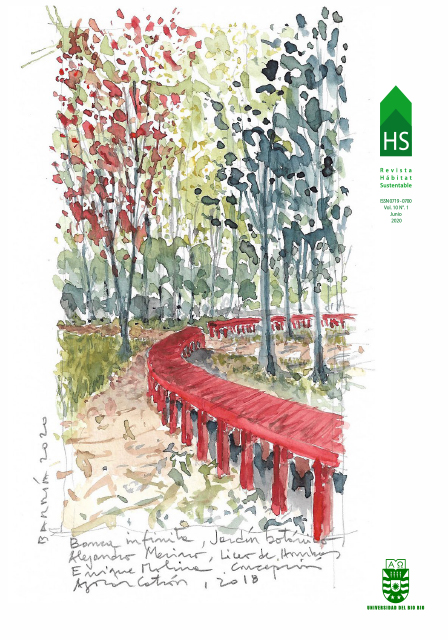Argentinean energy transition. The new energy efficiency standard in the evaluation of social housing. Case study: Barrio Papa Francisco
DOI:
https://doi.org/10.22320/07190700.2020.10.01.04Keywords:
ipe-index, social housing, iram11900:2017 standard, energy labelingAbstract
The building sector is responsible for 40% of the energy demand internationally, and for 37% in Argentina. Heating and cooling are the most representative item. Rational energy usage measures are being introduced in countries throughout the world, as well as strategies that pursue energy transition. The passing of the IRAM 11900 standard in Argentina promotes energy efficiency (EE) in the residential building sector, and it is expected to be inclusive and lead to the transition by 2050. The aim of this work is to perform the thermo-energy evaluation of an existing social dwelling prototype in “Barrio Papa Francisco” (Pope Francisco Neighborhood), as well as in its two improved variations: “retrofit” and “ex ante”. For this, information is collected about the dimensions, construction systems, building envelope components and equipment to meet demands for heating, cooling, domestic hot water and lighting. As a relevant result, it is reported that the energy supply index (IPE, in Spanish) of the existing prototype reaches a value of 132 kWhPrim./m2.year. In addition, the retrofit and ex ante variations lead to considerable economic savings in the initial investment. This is why the importance of implementing software analysis at the design stage is considered as important in order to quantify energy resources and emissions savings in a planned energy transition.
Downloads
References
Brent, A. C. y Petrick, W. (2007). Environmental impact assessment during project execution phases: towards a stage-gate project management model for the raw materials processing industry of the energy sector. Impact Assessment and Project Appraisal, 25(2), 111-122. https://doi.org/10.3152/146155107X205832
Chevez, P. (2017). Construcción de escenarios urbano-energéticos a partir de la implementación de estrategias de eficiencia energética y energías renovables en el sector residencial. Tesis doctoral. Universidad Nacional de Salta. Facultad de Ciencias Exactas Doctorado en Ciencias - Área Energías Renovables.
Etiquetado de Viviendas (2020). Aplicativo Informático Nacional 2020. Recuperado de http://etiquetadoviviendas.energia.gob.ar/
Evans, J. M., De Schiller, S. y Kozak, D. (2015) – Auditorías de comportamiento térmico y eficiencia energética en edificios con acondicionamiento natural. En: S. de Schiller y J.M. Evans (Eds.), Eficiencia Energética en el Hábitat Construido (pp. 191-202). Buenos Aires: CIHE-FADU-UBA.
Fernández, R. (coord.). (2019). Transición Energética 2050. Hacia una visión compartida de la transición energética argentina al 2050: propuesta de objetivos y metas. (Edición: J. Dumas y D. Ryan). Buenos Aires: Centro de Estudios de la Actividad Regulatoria Energética (UBA), Instituto Tecnológico de Buenos Aires (ITBA), Fundación AVINA, Programa de las Naciones Unidas para el Desarrollo, Secretaría de Gobierno de Energía.
Instituto de Vivienda de la Ciudad (IVC). (2016). Integración de los barrios. Recuperado de https://vivienda.buenosaires.gob.ar/#top
IRAM 11549 (2002). Instituto Argentino de Normalización y Certificación. Aislamiento Térmico en Edificios- Vocabulario.
Buenos Aires, Argentina.
IRAM 11601 (2002). Instituto Argentino de Normalización y Certificación. Aislamiento Térmico de Edificios: Métodos de
Cálculo. Buenos Aires, Argentina.
IRAM 11603 (2012). Instituto Argentino de Normalización y Certificación. Acondicionamiento térmico en Edificios: Clasificación Bioambiental de la República. Buenos Aires, Argentina.
IRAM 11900 (2017). Instituto Argentino de Normalización y Certificación. Prestaciones energéticas en viviendas. Método de cálculo y etiquetado de eficiencia energética. Buenos Aires, Argentina.
Kozak, D., Evans, J., Adamo, G., Abálsamo, D. y Romanello, L. (2017). Sustentabilidad en viviendas de escala intermedia en Buenos Aires. Revista Summa, 155, 102-110.
Kuchen, E., Plesser, S. y Fisch, M.N. (2012). Eficiencia energética y confort en edificios de oficina. El caso alemán. Revista Internacional Hábitat Sustentable, 2(2), 34-44.
Ley N° 13.059 (2003). Poder Legislativo de la Provincia de Buenos Aires. Acondicionamiento térmico de edificios de la Provincia de Buenos Aires. Cámara empresaria de desarrolladores urbanos de la República Argentina. Buenos Aires, 9 de abril de 2003.
Ley N° 13.903 (2017). Poder Legislativo de la Provincia de Santa Fe. Etiquetado de eficiencia energética de inmuebles destinados a vivienda. Cámara de Diputados de la Provincia de Santa Fe, 1 de octubre de 2017.
Li, F., Trutnevyte, E. y Strachan, N. (2015). A review of sociotechnical energy transition (STET) models”. Technological
Forecasting and Social Change, 100, 290-305. https://doi.org/10.1016/j.techfore.2015.07.017
Marinozzi, E. (2020). Informe Mensual CAMMESA. Principales Variables del Mes. Gerencia Análisis y Control Global. Mayo 2020. Recuperado de https://portalweb.cammesa.com/default.aspx
Riavitz, L., Zambon, H. y Giuliani, A. (2015). La matriz energética argentina y la restricción externa. Cuadernos de Investigación. Serie Economía, (5), 110-141.
Risuelo, F. (2010). Certificados de eficiencia energética en edificios. Resumen ejecutivo. Buenos Aires: FODECO.
Secretaría de Energía de la Nación (SEN). (2020) Eficiencia Energética: Programas. SEN 2020. Recuperado de https://www.argentina.gob.ar/produccion/energia
Secretaría de Medio Ambiente y Desarrollo Sustentable (MAyDS) (2017). Inventario de Gases de Efecto Invernadero de Argentina. Recuperado de https://www.argentina.gob.ar/sites/default/files/inventario-nacional-gei-argentina.pdf
Downloads
Published
How to Cite
Issue
Section
License
The content of articles which are published in each edition of Habitat Sustentable, is the exclusive responsibility of the author(s) and does not necessarily represent the thinking or compromise the opinion of University of the Bio-Bio.
The author(s) conserve their copyright and guarantee to the journal, the right of first publication of their work. This will simultaneously be subject to the Creative Commons Recognition License CC BY-SA, which allows others to share-copy, transform or create new materials from this work for non-commercial purposes, as long as they recognize authorship and the first publication in this journal, and its new creations are under a license with the same terms.











 Scientific Information Program/Concurso Fondos de Publicación de Revistas Científicas 2018/ Proyecto Mejoramiento de Visibilidad de Revistas UBB (Código:FP180007).
Scientific Information Program/Concurso Fondos de Publicación de Revistas Científicas 2018/ Proyecto Mejoramiento de Visibilidad de Revistas UBB (Código:FP180007).





